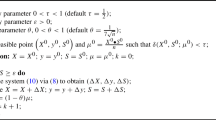Abstract
In this paper we show that the primal-dual Dikin affine scaling algorithm for linear programming of Jansen. Roos and Terlaky enhances an asymptotical\(O(\sqrt n L)\) complexity by using corrector steps. We also show that the result remains valid when the method is applied to positive semi-definite linear complementarity problems.
Similar content being viewed by others
References
E.R. Barnes, “A variation on Karmarkar’s algorithm for solving linear programming problems,”Mathematical Programming 36 (1986) 174–182.
D.A. Bayer and J.C. Lagarias, “The nonlinear geometry of linear programming: I. Affine and projective scaling trajectories, II. Legendre transform coordinates and central trajectories,”Transactions of the American Mathematical Society 314 (1989) 499–581.
I.I. Dikin, “Iterative solution of problems of linear and quadratic programming,”Doklady Akademiia Nauk SSSR 174 (1967) 747–748.
C.C. Gonzaga, “An algorithm for solving linear programming programs in O(n 3L) operations,” in N. Megiddo, ed.,Progress in Mathematical Programming, Interior Point and Related Methods (Springer, New York, 1988) pp. 1–28.
P.-F. Hung and Y. Ye, “An asymptotical\(O(\sqrt n L)\)-iteration path-following linear programming algorithm that uses long steps,” Working Paper, College of Business Administration, The University of Iowa, Iowa City, IA (1994).
B. Jansen, C. Roos, and T. Terlaky, “A polynomial primal-dual Dikin-type algorithm for linear programming,”Mathematics of Operations Research 21 (1996) 341–353.
B. Jansen, C. Roos, and T. Terlaky, “A family of polynomial affine scaling algorithms for positive semi-definite linear complementarity problems,” Technical Report 93-112, Faculty of Technical Mathematics and Computer Science, Delft University of Technology, Delft, Netherlands (1993).
M. Kojima, S. Mizuno, and A. Yoshise, “A primal-dual interior point algorithm for linear programming,” in: N. Megiddo, ed.,Progress in Mathematical Programming, Interior Point and Related Methods (Springer, New York, 1989) pp. 29–47.
M. Kojima, S. Mizuno, and A. Yoshise, “A polynomial-time algorithm for a class of linear complementarity problems,”Mathematical Programming 44 (1989) 1–26.
I.J., Lustig, R.E. Marsten and D.F. Shanno, “Computational experience with a primal-dual interior point method for linear programming”Linear Algebra and its Applications 152 (1991) 191–222.
N. Megiddo, “Pathways to the optimal set in linear programming,” in N. Megiddo, ed.,Progress in Mathematical Programming. Interior Point and Related Methods (Springer, New York, 1988) pp. 131–158.
S. Mehrotra, “On the implementation of a (primal-dual) interior point method.”SIAM Journal on Optimization 2 (1992) 575–601.
R.C. Monteiro and I. Adler, “Interior path following primal-dual algorithms. Part I: Linear programming,”Mathematical Programming 44 (1989) 27–42.
R.C. Monteiro, I. Adler and M.G.C. Resende, “A polynomial-time primal-dual affine scaling algorithm for linear and convex quadratic programming and its power series extension,”Mathematics of Operations Research 15 (1990) 191–214.
S. Mizuno, M.J. Todd, and Y. Ye, “On adaptive-step primal-dual interior-point algorithms for linear programming.”Mathematics of Operations Research 18 (1993) 964–981.
C. Roos and J.-Ph. Vial, “Long steps with the logarithmic penalty barrier function in linear programming,” in: J. Gabszeywicz, J.F. Richard, and L. Wolsey, eds.,Economic Decision Making: Games, Economics and Optimization (Elsevier Science Publishers, Amsterdam, 1989) pp. 433–441.
J. Renegar, “A polynomial-time algorithm based on Newton’s method for linear programming,”Mathematical Programming 40 (1988) 59–94.
G. Sonnevend, “An analytical center for polyhedrons and new classes of global algorithms for linear (smooth, convex) programming,” in:Lecture Notes in Control and Information Sciences, Vol. 84 (Springer, New York, 1985) pp. 866–876.
R.J. Vanderbei, M.S. Meketon and B.A. Freedman, “A modification of Karmarkar’s linear programming algorithm.”Algorithmica 1 (1986) 395–407.
Y. Ye, M.J. Todd, and S. Mizuno, “An\(O(\sqrt n L)\)-iteration homogeneous and self-dual linear programming algorithm,”Mathematics of Operations Research 19 (1994) 53–67.
L. Zhang and Y. Zhang, “On polynomiality of the Mehrotra-type predictor-corrector interior-point algorithms,” Technical Report 93-12, Department of Mathematics and Statistics, University of Maryland at Baltimore County, Baltimore, MD (1993).
Author information
Authors and Affiliations
Additional information
This work was done while the fourth author was visiting Delft University of Technology on a grant of the Dutch Organization for Scientific Research (NWO). The first author is supported by the Dutch Organization for Scientific research (NWO), grant 611-304-028. The third author is on leave from the Eötvös University, Budapest, and partially supported by OTKA No. 2116. The fourth author is partially supported by NSF Grant DDM-9207347. The work of the third and the fourth author is partially supported by an Obermann Fellowship of the Advanced Research Center of the University of Iowa.
Rights and permissions
About this article
Cite this article
Jansen, B., Roos, C., Terlaky, T. et al. Improved complexity using higher-order correctors for primal-dual Dikin affine scaling. Mathematical Programming 76, 117–130 (1997). https://doi.org/10.1007/BF02614380
Received:
Revised:
Issue Date:
DOI: https://doi.org/10.1007/BF02614380




